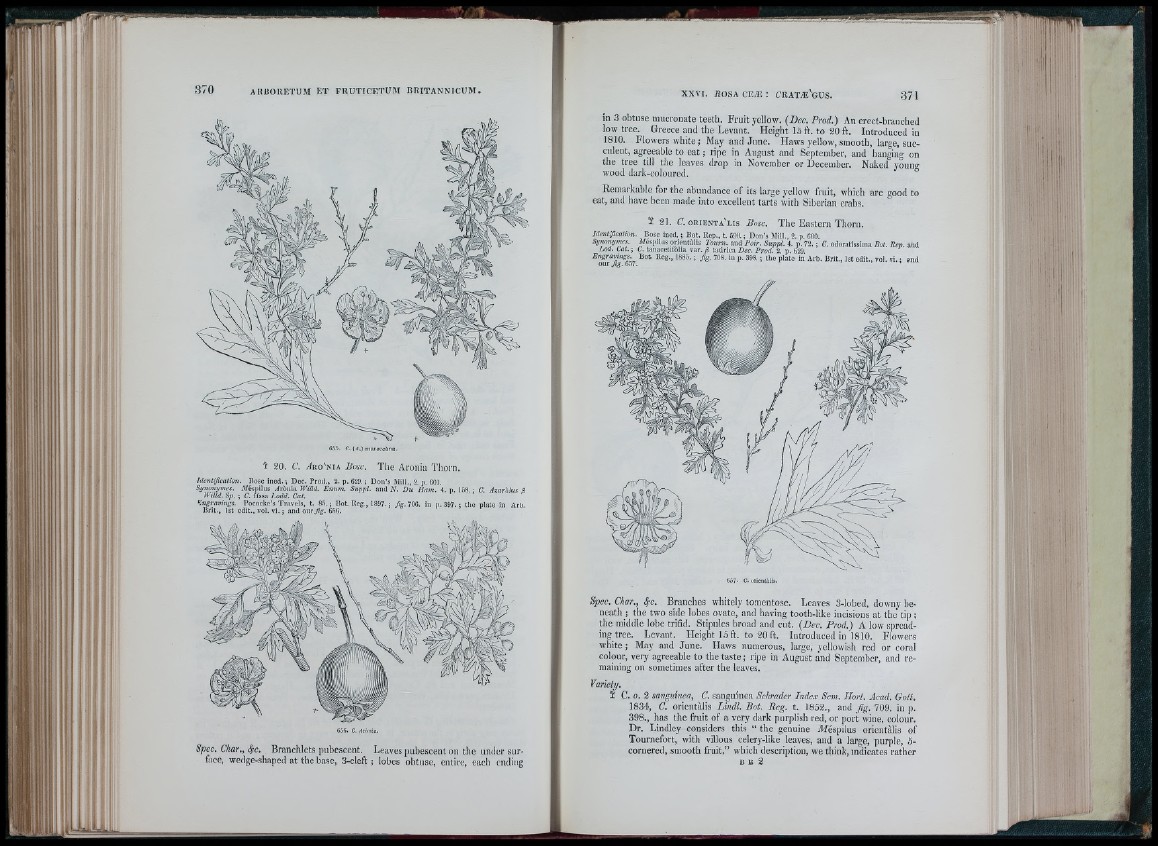
i
; 1
0,1,'). r . (di.) n iavorcàna.
ì 20. C. /Ìro'nia Jiosc. The Aronia Tliorn.
Identificaiion. Rose ined. ; Dee. Prod., 2. p. 629. ; Don’s Mill., 2. p. 601.
Syno7i!/mes. .1/éspilus /irònia Willd. Enum. Suppl. and N. D u Hain. 4. p. 158.; C. Azaròlus 3
Willd. Sp. ; C. fissa Lodd. Cat.
Engravings. Pococke’s Travels, t. 8.5.; Bot. Keg., 1897. ; Jig.lOQ. in p.397. ; the plate in Arb.
B n t., 1st edit., vol. vi. ; and o u rjig . 6.56.
656. C. /ironia.
Spec. Char., f r . Branchlets pnbe.scent. Leaves pubescent on the under surface,
wedge-shaped at tbe base, 3-cleft ; lobes obtuse, entire, each ending
in 3 obtuse mucronate teeth. Fruit yellow. (Dec. Prod.) An erect-branched
low tree. Greece and the Levant. Height 15 ft. to 20 ft. Introduced in
1810. Flow e rsw hite ; May and June. Haws yellow, smooth, large, succulent,
agreeable to eat ; ripe in August and September, and hanging on
the tree till the leaves drop in November or December. Naked young
wood dark-coloured. ®
Remarkable for the abundance of its large yellow fruit, which are good to
eat, and have been made into excellent tarts with Siberian crabs.
15 21. C. o r i e n t a ' l i s B o s c . The Eastern Thorn.
Identification. Bosc ined. ; Bot. Rep., t. 590. ; Don’s Mill., 2. p. 600.
Synoriijmes. MespiUis orientàlis Tourn. and Poir. Suppl. 4. p. 72. ; C. odoratissima Bot. Rep. and
Lod. Cat. ; C. tanacetifòlia var. fi tauric a Dec. Prod. 2 p. 629
AÌfIjOT vol. vl. ; Hid
657- C. orientàlis.
Spec. Char., f r . Branches wliitely tomentose. Leaves 3-lobed, downy beneath
; tbe two side lobes ovate, and having tootli-like incisions at the tip ;
tbe middle lobe trifid. Stipules broad and cut. (Dec. Prod.) A low spreading
tree. Levant. Height 15 ft. to 20 ft. Introduced in 1810. Flowers
white ; May and June. Haws numerous, large, yellowish red or coral
colour, very agreeable to the ta ste; ripe in August and September, and remaining
on sometimes after the leaves.
Variety.
Í C. o. 2 sanguinea, C. sanguínea Schrader Index Sem. Hort. Acad. Gott.
1834, C. orientàlis Lindl. Bot. Reg. t. 1852., and Jig. 709. in p.
398., has the fruit of a very dark purplish red, or port wine, colour.
Dr. Lindley considers this “ the genuine Aíéspilus orientàlis of
Tournefort, with villous celery-like leaves, and a large, purple, 5-
cornered, smooth fruit,” which description, we tiiink, indicates rather
B u 2